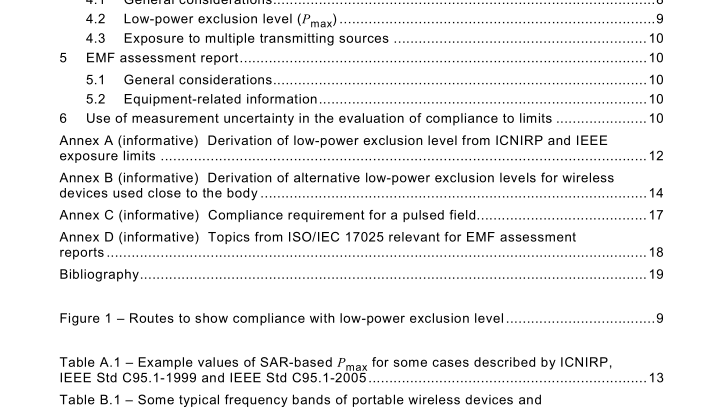IEC 62479:2010 pdf download – Assesment of the compliance of low-power electronic and electrical equipment with the basic restrictions related to human exposure to electromagnetic fields (10 MHz to 300 GHz)
4 Conformity assessment methods
4.1 General considerations Compliance of electromagnetic emissions from electronic and electrical equipment with the basic restrictions usually is determined by measurements and, in some cases, calculation of the exposure level. If the electrical power used by or radiated by the equipment is sufficiently low, the electromagnetic fields emitted will be incapable of producing exposures that exceed the basic restrictions. This standard provides simple EMF assessment procedures for this low power equipment. Any relevant compliance assessment procedure which is consistent with the state of the art, reproducible and gives valid results can be used. For transmitters intended for use with more than one antenna configuration option, the combination of transmitter and antenna(s) which generates the highest available antenna power and/or average total radiated power shall be assessed. Four routes, as illustrated in Figure 1 and described as follows, can be used to demonstrate compliance with this standard:
A Typical usage, installation and the physical characteristics of equipment make it inherently compliant with the applicable EMF exposure levels such as those listed in the bibliography. This low-power equipment includes unintentional (or non-intentional) radiators, for example incandescent light bulbs and audio/visual (A/V) equipment, information technology equipment (ITE) and multimedia equipment (MME) that does not contain radio transmitters. NOTE Equipment is described as A/V equipment, ITE or MME if its main use is playback/recording of music, voice or images, or processing of digital information.
B The input power level to electrical or electronic components that are capable of radiating electromagnetic energy in the relevant frequency range is so low that the available antenna power and/or the average total radiated power cannot exceed the low-power exclusion level defined in 4.2.
C The available antenna power and/or the average total radiated power are limited by product standards for transmitters to levels below the low-power exclusion level defined in 4.2.
D Measurements or calculations show that the available antenna power and/or the average total radiated power are below the low-power exclusion level defined in 4.2. If none of these routes can be used, then the equipment is deemed to be out of the scope of this standard and EMF assessment for conformity assessment purposes shall be made according to other standards, such as IEC 6231 1 or other EMF product standards.
4.2 Low-power exclusion level (P max ) Low-power electronic and electrical equipment is deemed to comply with the provisions of this standard if it can be demonstrated using routes B, C or D that the available antenna power and/or the average total radiated power is less than or equal to the applicable low-power exclusion level P max . Annex A contains example values for P max derived from existing exposure limits listed in the bibliography, such as the ICNIRP guidelines [1 ], IEEE Std C95.1 -1 999 [2], and IEEE Std C95.1 -2005 [3]. For wireless devices operated close to a person’s body with available antenna powers and/or average total radiated powers higher than the P max values given in Annex A, the alternative P max values (called P max ′), described in Annex B can also be used. NOTE In order to be able to use the alternative P max values (P max ′), the device under assessment shall fit within the scope of applicability of P max ′ as defined in Annex B. If P max ′ as defined in Annex B is not applicable to a particular product, then the example values P max for the corresponding exposure limits described in Annex A should be used. For low power equipment using pulsed signals, other limits may apply in addition to those considered in Annex A and Annex B. Both ICNIRP guidelines [1 ] and IEEE standards [2], [3] have specific restrictions on exposures to pulsed fields, and the requirements of those standards with respect to exposure to pulses shall be met. Annex C discusses this topic further.
